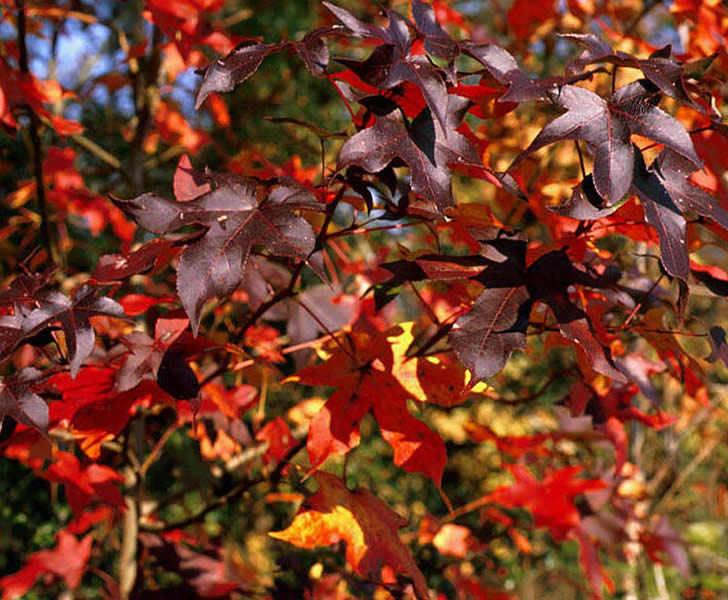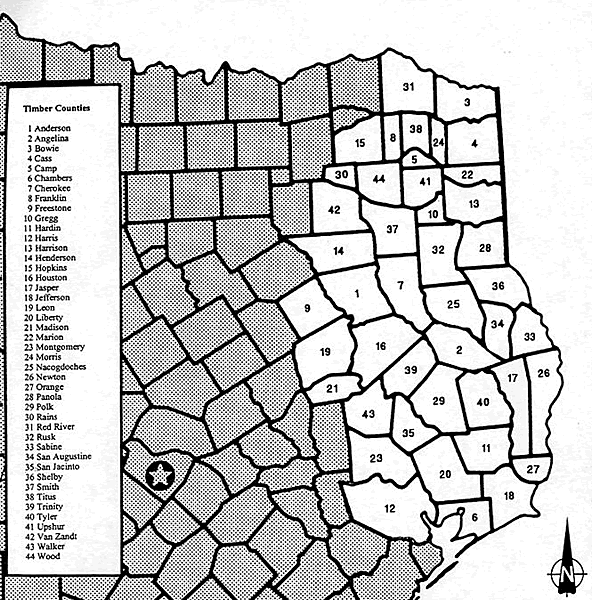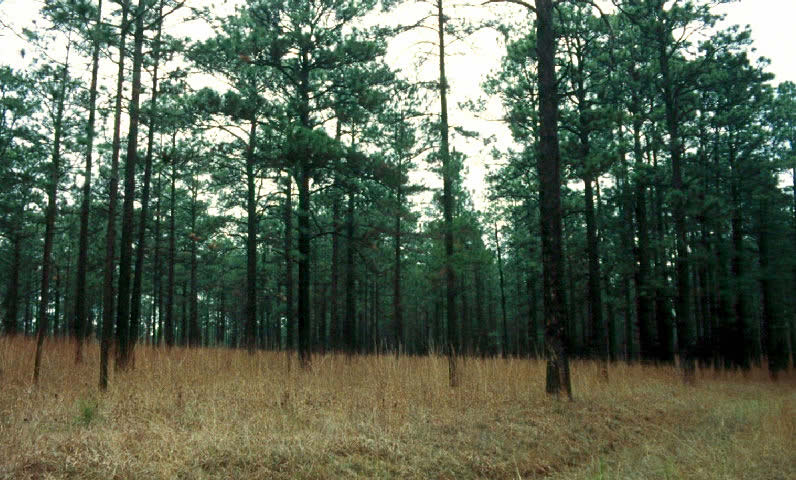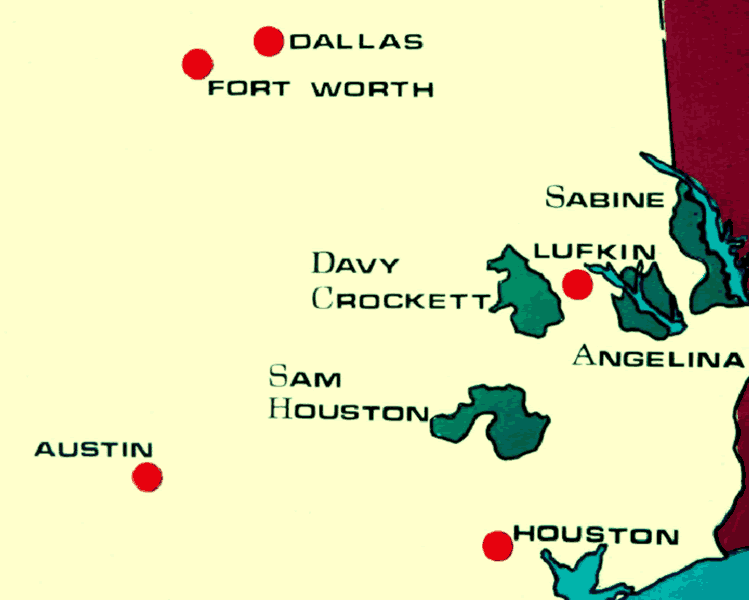
Trees such as the sweetgum, above,
and southern red oak provide a brilliant flash of fall
color in contrast to the dark evergreen pines in East
Texas forests. Photo by Benny J. Simpson, courtesy of
Texas A&M University at Dallas.
|

Lacy green ferns dance above the
pine-needle covered forest floor in the Angelina National
Forest. Photo by Richard Reynolds, courtesy Texas Department
of Transportation. Click to enlarge.
|

The 44 Texas counties
included in the Pineywoods region, all
of which produce timber commercially.
Map courtesy of USDA Forest Service.
Click to enlarge.
|

The large, rough cap on acorns of
the swamp post oak are a distinctive feature on this
common East Texas tree, also known as water white oak
and overcup oak. Photo by Benny J. Simpson, courtesy
of Texas A&M University at Dallas.
|

A stand of second-growth
longleaf pine. Photo courtesy USDA Forest
Service.
|
|
The pine forest lands or "Pineywoods"
of East Texas extend from the Red River in the northeast corner
of the state, southward to the region bordering Galveston
Bay, and from the Louisiana border on the east to the Black
Prairie region on the west. As shown in the maps below, this
area includes all or portions of 44 Texas counties.
Although there are a few isolated pockets in
other parts of the state (the woods at Bastrop State Park
in Central Texas and in the far western Trans-Pecos regions
being notable examples), Texas pine forests are contained
in the eastern part of the state because of favorable soil
conditions. Bordering the Pineywoods on the west is a band
of hardwood forest commonly referred to as the Post Oak Belt.
Outside this belt is the first true grassland, known as the
Black Prairie, characterized by a deep black lime-rich soil
over limestone and marl, a combination of soil and substrate
that deters the encroachment of pine into the area.
The Pineywoods region encompasses the four National
Forests in Texas: the Angelina, Davy Crockett, Sabine, and
Sam Houston. Together these four forests cover a total of
637,386 acres in south and central East Texas, and include
portions of Angelina, Houston, Jasper, Montgomery, Nacogdoches,
Newton, Sabine, San Augustine, San Jacinto, Shelby, Trinity,
and Walker counties.
The topography in East Texas is gently rolling
to hilly in the north and central areas, becoming flatter
near the Gulf of Mexico. It is a well-watered area and contains
the Angelina, Neches, Sabine, and Trinity rivers as well as
many creeks and bayous. This varied terrain—from dry
to moist uplands, to creek and riverbottoms, to swamp forest
communities—produces quite different groupings of vegetation.
In their illustrated 1985 volume, Trees, Shrubs, and Woody
Vines of East Texas, Elray Nixon and Bruce Cunningham
organize the vegetation of East Texas into plant communities
based on terrain, soil, and moisture conditions. These are
described below.
Hardwoods tend to be dominant in the dry
upland areas, where the soil is sandy and well drained.
Post oak (Quercus stellata), black hickory (Carya
texana), blackjack oak (Q. marilandica), sandjack
oak (Q. incana), and black oak (Q. velutina)
are among the most common species. Pines also grow with some
frequency in this area, with shortleaf (Pinus echinata)
found in the north and central areas and longleaf (P. palustris)
in the southeast. Other trees are sweetgum (Liquidamber
styraciflua), red mulberry (Morus rubra), woollybucket
bumelia (Bumelia lanuginosa), southern red oak (Q.falcata),
sassafras (Sassafras albidum), winged elm (Ulmus
alata), and rusty blackhaw (Viburnum rujidulum).
Loblolly pines (Pinus taeda) are found
in the more moist upland areas where the soil retains
more water throughout the year. Other trees growing in this
area are southern red oak, sweetgum, winged elm, water oak
(Q. nigra), black cherry (Prunus serotina),
flowering dogwood (Cornus florida), mockernut hickory
(Carya tomentosa), sassafrass, fringetree (Chionanthus
virginica), black gum (Nyssa sylvatica), sugar
maple (Acer saccharum), and American elm (Ulmus
americana). The understory growth in the mesic uplands
includes dwarf pawpaw (Asimina parviflora), red buckeye
(Aesculus pavia), American beautyberry, poison ivy,
bristleleaf blueberry (Vaccinium amoenum), southern
wax myrtle (Myrica cerifera), farkleberry, Carolina
holly (flex ambigua), common witchhazel (Hamamelis
virginiana), yaupon, and arrowwood viburnum (Viburnum
dentatum).
The well-drained, fertile soils of the creek
and river bottoms, (the mesic bottomlands) produce
dense stands of trees and shrubs. Overstory vegetation (taller
trees growing above smaller varieties, shrubs, and vines)
includes red maple (Acer rubrum), white oak (Quercus
alba), swamp post oak (Quercus lyrata), American
hornbeam (Carpinus caroliniana), river birch (Betula
nigra), bitternut hickory (carya cordiformis),
American beech (Fagus grandiflora), American holly,
sweetgum, black gum, sweetbay magnolia (Magnolia virginiana),
water oak, and prickly ash. In the understory are a variety
of shrubs and vines including American beautyberry, deciduous
holly (Ilex decidua), common pawpaw (Asimina triloba),
giant cane (Arundinaria gigantea), farkelberry, poison
ivy, Virginia creeper, muscadine grape, laurel greenbrier
(Smilex laurifolia), and Carolina snailseed.
|

East Texas encompasses
four national forests, covering a total
of 637,386 acres. Map courtesy of USDA
Forest Service.
|

Like a bright beacon
in the deep woods, the white flowers
of the dogwood tree are a familiar sight
during early spring in East Texas. Photo
by Greg White, courtesy Texas Department
of Transportation.
|

Long silky needles are the dominant
feature of young longleaf pine plants. In this "grassy"
stage, seedlings produce thick clusters of long needles
but remain only a few inches high for up to 25 years
while they develop a deep taproot. Photo by Benny J.
Simpson, courtesy of Texas A&M University at Dallas.
|

A bald cypress towers
over a river bank in East Texas. Cypress
trees were an important resource in
the logging trade; the wood was used
to make lumber as well as roofing shingles.
Photo courtesy of USDA Forest Service.
|

Muscadine grapes are a common understory vine in forested areas and bottomlands of East Texas. Photo courtesy of Texas Parks and Wildlife Department.
|
|